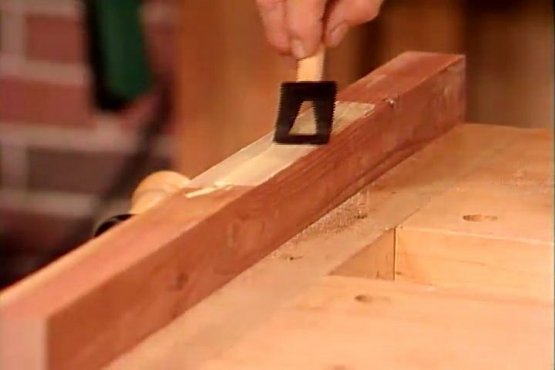RON HAZELTON:
You know where sports and woodworking come together? Well in the making of baseball bats for one. Now this is a billet. The hunk of wood for which a bat is turned. And this is what the billet looks like fresh off the lathe. I picked both of these up at a visit to the Louisville Slugger factory. Recently I went to the home of another baseball institution, Cooperstown, New York.
Besides the Baseball Hall of Fame, there are a couple of other historic institutions there. Located on the site of a former dairy farm, this living museum is dedicated to 19th-century rural America. Along with exhibits and artifacts that are housed in this century old barn, the museum features 12 historic buildings relocated here from the surrounding area.
They form a true to life 19th century farm community where even the games are from another era. The farmers museum also houses the American paper staining manufactory where artisan Wendy Weeks creates wallpaper using 19th century paint and block print techniques.
Hey Wendy.
WENDY WEEKS:
Hi Ron.
RON HAZELTON:
In the 1800s, long rolls of paper were not available. So our first step is to glue individual sheets together to form a roll.
WENDY WEEKS:
Very good, Ron.
[BOTH SPEAK AT ONCE]
WENDY WEEKS:
Very good.
RON HAZELTON:
That's incredible. One long strip of wallpaper. Then we paint it green. The base color of our soon to be wallpaper. Now it's time to create the pattern.
WENDY WEEKS:
This is called a sieve and what it is basically is a felt that's sitting on a canvas coated like a canoe. It is sitting in the trough of water. So I'm having some buoyancy to the bottom of this felt.
[BOTH SPEAK AT ONCE]
This is basically a stamp pad. And I have a block here that we're gonna use. This is an 1830s wallpaper pattern and this will be the first block that we're going to use with white paint.
RON HAZELTON:
So you're going to put the paint on the felt.
[BOTH SPEAK AT ONCE]
WENDY WEEKS:
So what're going to do is put the paint on the felt. And saturate it like I said, very much like a stamp pad.
RON HAZELTON:
I'll be darned. Look at this. Wendy applies paint to the wood block by tapping it a few times on the felt. Then she pressed it onto a long roll of paper.
WENDY WEEKS:
Bridge is going to come over across the - the block and we're going to press it with a long lever against the post -
RON HAZELTON:
Would this hap - by any chance be the lever I'm leaning on right now.
WENDY WEEKS:
I think it is.
RON HAZELTON:
Get out of your way.
WENDY WEEKS:
Now most apprentices would never do that in front of the master. But we'll give it a try.
RON HAZELTON:
Okay. I'm sorry. It will never happen again. Wow this is kind of -
[BOTH SPEAK AT ONCE]
WENDY WEEKS:
Now if you would like, go all the way to the end of the -
[BOTH SPEAK AT ONCE]
RON HAZELTON:
So it takes this much pressure to make this work?
WENDY WEEKS:
That's right.
RON HAZELTON:
It's pushed down once.
WENDY WEEKS:
Yes, that sounds good. Let's see what it looks like.
RON HAZELTON:
You want that sort of creaky sound.
[BOTH SPEAK AT ONCE]
WENDY WEEKS:
Well you're stronger than I am so -
RON HAZELTON:
I'm heavier. So should I put this back over here.
[BOTH SPEAK AT ONCE]
WENDY WEEKS:
Now bring it back -
RON HAZELTON:
I don't want to do anything unless I'm instructed to. Because I am after all, the apprentice here.
WENDY WEEKS:
Back to the cradle. There you are. Very gently bring it up.
RON HAZELTON:
Straight up.
WENDY WEEKS:
Straight up. Excellent.
RON HAZELTON:
Wow.
WENDY WEEKS:
Beautiful job.
RON HAZELTON:
Now, explain to me why we have these -
WENDY WEEKS:
Registration pins.
RON HAZELTON:
Registration pins.
WENDY WEEKS:
That is allowing for me to know where to set the block down again. You have the pin that has left a dot in the beginning of the pattern and one at the end. It will be this dot that will be used to continue the pattern down the length of the paper.
RON HAZELTON:
Okay so what - so what dot we'll place on top of this dot and that makes sure that everything is - looks continuous.
WENDY WEEKS:
That's right. Good, beautiful.
RON HAZELTON:
So this is our second block here right.
WENDY WEEKS:
Correct, this is the second block. For every color on the wallpaper pattern, you usually have another block of wood. So this is going to be the second image produced on your paper. Oh beautiful. That's a beautiful shot.
[BOTH SPEAK AT ONCE]
RON HAZELTON:
That’s about it.
WENDY WEEKS:
It's great.
RON HAZELTON:
That looks great. You know this really is a lost art, isn't it.
WENDY WEEKS:
Yes, it is. And we're very happy to be doing this at the farmer's museum to revive this lost art.
RON HAZELTON:
As I look around the American paper staining manufactory, it's abundantly clear just how creative skilled and patient the artisans of centuries past truly were.








